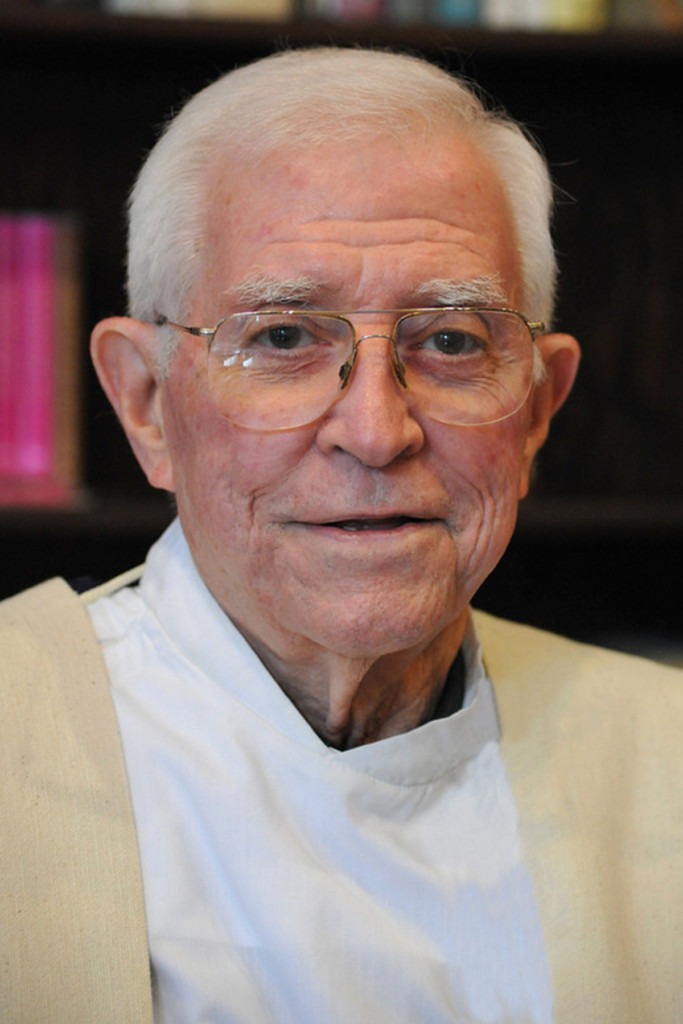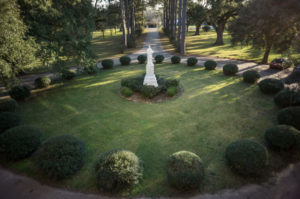Many measure one’s eminence through their legacy: their impact on the community and the number of lives touched during their time on earth. By these standards, Reverend Charles A. Leininger, SJ surely lives among the greats. His 76 years in the Jesuit order have been replete with helping others and working to make his community a better place.
Jesuit Formation
Novitiate
After completing the novice training at St. Charles, they brothers professed their first vows together in 1942.
First Studies
Charles and Joseph stayed at St. Charles to study humanities then went on to study philosophy at Spring Hill College in Mobile, Alabama. He graduated with a bachelor’s degree in history from Spring Hill in 1946.
Regency
For the next three years, Charles would return back to the Jesuit High School of Louisiana to complete his regency, beginning his career of teaching at his alma mater.
Theology Studies
The brothers reunited during their theological studies at St. Mary’s College in St. Marys, Kansas from 1950-1954, where Charles was awarded the licentiate in sacred theology.
Ordination
Charles and Joseph were ordained to the priesthood on June 17, 1953, at St. Joseph’s Chapel on the Spring Hill College campus.
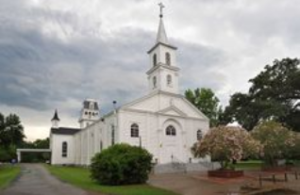
Tertianship
The twins pronounced their final vows together on Aug. 15, 1957, in Sacred Heart Church (now St. Charles Borromeo), Grand Coteau.
Teaching Career Before Jesuit
Following ordination, Father Leininger was assigned principal of the Jesuit High School in Shreveport, Louisiana in 1955 and remained there until 1965. He was named principal of Jesuit High School in New Orleans in 1965 and two years later, became the academic assistant principal of Strake Jesuit College Preparatory School in Houston. After working at Strake Jesuit from 1967-1971, he was named as Socius, or executive assistant, to former New Orleans Provincial Thomas Clancy, SJ and appointed a province consultor. While functioning as Socius, he also served as director of Secondary Education in the New Orleans Province for three years. He returned back to his career in education at Jesuit High School in Tampa, Florida, where he served as academic assistant principal from 1975 – 1976 and principal from 1976 – 1978. He served as Socius for another three years from 1978 – 1981 under Provincial Thomas Stahel, SJ before finally returning to what would be his home for the next 30+ years: Jesuit College Preparatory School of Dallas.
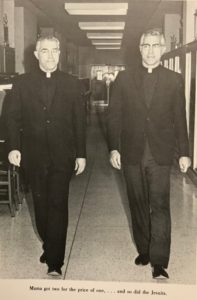
Jesuit Dallas Legacy
Father Leininger began teaching at Jesuit Dallas in 1982, where he remained until his death 36 years later. Thousands of Jesuit students have been granted the privilege of placement into one of Father Leininger’s English, Latin, or Ceramics classes. Describing his class as austere would be an understatement, quickly earning the reputation of a strict, yet equally sensational teacher. While countless alums recall his class as the one that whipped them into shape their freshman year, Father Leininger’s zeal for teaching came from a love of learning and a love of connecting with students.
From Students to Colleagues
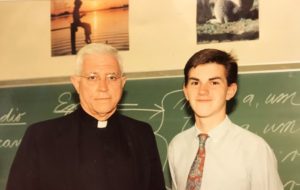
Among the thousands of alum who experienced Father Leininger’s authoritarian rule include a handful of current teachers and administrators at Jesuit, such as Mr. Joe Nava ‘02, Mr. Andy Civello ‘97, Dr. Ben Kirby ‘00, and Mr. Seth Waits ‘01.
Mr. Nava
Sharing his experience under the direct rule of Fr. Leininger in his 1998 freshman English class, Nava esteemed:
“CA was the teacher who could command the room – simply by his silent presence. He kept us engaged by keeping us on edge, primarily out of fear, fear of being called on and yet he was inspiring because of his intelligence, his holiness, and his patience with all of his students – his class was my introduction to Jesuit education – and what it meant and what it would require of me. Also, I can still confidently diagram any sentence, and I believe this simple and “outdated” skill has been the foundation of my ability to read and understand what I read, especially throughout my high school, college, and masters education.”
Mr. Andy Civello
Relishing the certainty with which Fr. Leininger commanded his class, Mr. Civello praised how the class helped shape his freshman experience:
“He was very structured in the sense of his classroom. You knew exactly what you were going to get: exactly what you could and couldn’t do. And that was everything from going to the bathroom to taking your jacket off. It was good in that sense, that as a freshman you knew exactly what to expect. You knew exactly what you needed to prepare for and exactly what you were expected to know going into the class. He would have a definite requirement of what you would be doing in class, and if you had a good idea of what that was, you would be fine in class the next day. I think that was really helpful as a freshman, that you knew exactly what you were going to do in class and exactly what was expected of you. In that case, I thought his class was really helpful. In the transition period as a freshman, it made my experience a whole lot easier because I knew exactly what the expectation was.”
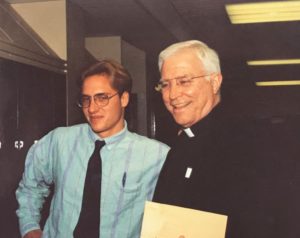
Dr. Ben Kirby
Reflecting on the transformation of his relationship with Father Leininger over the years, Dr. Kirby recounting several of their most vivid memories:
“Fr. Leininger had a special place in my life and in the Jesuit community. His physical presence over the last several years has changed; however, he never failed to command a room when he had a question or a recommendation. If someone asked me to describe him when I was a student in his class, I would have used these words: stern, fair, intelligent, and challenging. If someone asked me to describe him as a colleague, I would have used these words: passionate, humorous, and intelligent. He was someone who remembered everything and seemed to know everything, especially as it related to literature, Jesuit history, and stamps. He was fun to talk with as a peer and I know that he was always looking out for the best interest of others.
I remember asking if I could take my blazer off in his English class because I was sweating and hot. He looked at me from behind his podium and asked, ‘Mr. Kirby, is it 185 degrees in the shade of the statue outside the window?’ I replied, ‘no, sir.’ He replied, ‘that is my answer to your question, as well. No, sir. If your answer to my question changes I will reconsider mine to yours.’
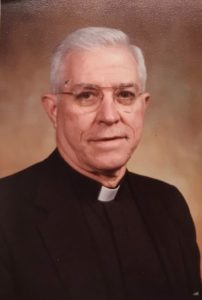
I remember another teacher coming into our English class to observe. Though I don’t remember that happening much during my time as a student, I remember him asking the guest, ‘would you like to know what we are doing?’ The guest answered, ‘sure.’ He then asked me to recite the last passage from David Copperfield verbatim from what he had just read to us. I had no idea. He then asked me, ‘Mr. Kirby, should I just mark you absent for the day or are you ready to attend my class?’
I remember Father telling my English class sometime during my freshman year (1996-1997) that he would never leave Dallas Jesuit until God took him home. I specifically remember him telling us that he wanted to finish teaching his class, walk down the hallway to his bedroom (the Jesuits were obviously still living on campus), and take a nap and wake up in heaven. My prayer is that it was that simple. If I had to bet on one person who could convince God of how something should be done…I would be all-in for Father Leininger.”
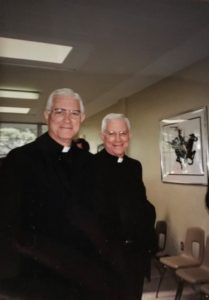
Mr. Seth Waits
Another of Fr. Leininger’s pupils, Mr. Waits compiled memories of his relationship with Fr. Leininger from his time as a student in 1997 to being colleagues less than 10 years later in a tribute he presented at the funeral mass on March 21.
“After the first major assessment in my section of English 1 in the fall of 1997, a student who had earned a less-than-satisfactory grade asked Fr. Leininger if he planned to curve the test scores. Father nodded his head slowly, turned around, and walked three steps toward the blackboard. He picked up a long piece of white chalk, drew the digits 3 and 8 about two feet tall apiece, and turned back around to face the inquiring student.
‘This number has a lot of curves in it,’ Father explained. ‘Would you like to trade your grade for this one?’
‘No, I guess I’ll stick with what I have,’ the kid replied in a barely audible tone. No student asked for a curve on an exam for the remainder of the school year.
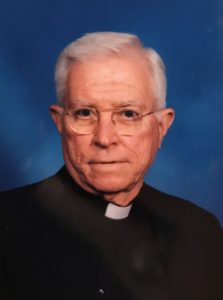
Fr. Leininger’s reputation as a hard grader and a demanding instructor made its way into even the ranks of those who had yet to walk the Jesuit halls as students. When incoming students received their schedules in the mail in mid-July, they would call their friends not asking who placed into honors algebra or honors biology, but who had Leininger for freshman English.
Legend had it that CA had been a boxer in his early years, and a good one at that. His impressive height and his imposing frame, even into his sixties and seventies, made this easy for any student to believe. One night, CA pummeled an opponent so badly in the ring that the man soon died from his injuries. CA, so tortured by the tragedy he had caused with his own hands, turned to the priesthood to atone for his misdeed and prevent himself from inflicting harm on anyone else again.
Students who would ask Father about this incident during the year would typically receive a long, quiet stare in response. No confirmation, yet no denial, either.
Many alums who had Fr. Leininger as an English teacher and currently teach at Jesuit have shared with me how much they enjoyed getting to know CA as a colleague and a “real person” since returning to the school. I certainly include myself in this group. He would regularly ask us about our families and kids, and even let us know he was praying for us if he knew we needed a prayer said on our behalf.
I liked reciprocating by asking Father about his interests and what projects he was working on at the moment (he still had several in the air as last week). Oftentimes a twinkle would glint in his eyes just before he would launch into a detailed explanation of his latest undertaking. This is not an exaggeration—if you looked directly into them, you could see the man’s eyes really twinkle when he became excited about discussing a topic with you.”

Outside the Classroom
Mr. Keith Reese
A close companion of Father Leininger’s for decades, Mr. Reese recalled their perpetual friendship:
“Fr. Leininger was a trusted confidant, good friend and a man of deep prayer. In addition to the paintings he contributed to the Jesuit Museum, he is responsible for the design of the beautiful stained glass cross in the Terry Center. An excellent educator and a master at cards, Fr. Leininger enjoyed visits to the casino. On one occasion we were ready to leave the casino and Fr. Leininger said to give him a few minutes. Almost 1 hour later, he was still at the machine continuing his well planned stakes. Anytime he won extra money, he would donate it to a special cause that was dear to his heart. He always made certain he returned any money back to the Jesuit treasury in the house where he lived. Fr. Leininger was an absolute treasured friend to many of us who know him.”
Father Wally Sidney, SJ
Living with Father Leininger over the past two years, Fr. Sidney also expressed his admiration and respect for the late Father:
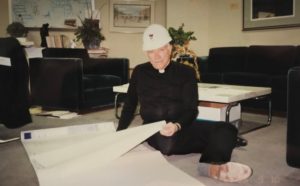
“The attribute I admired most in Fr. Leininger was his love of teaching. He was known as a hard teacher but a fair one. He demanded the best from his students and would not settle for anything less. Love of teaching did not stop with the classroom. He genuinely cared for his students and would do anything for them. I believe that what he wanted most for his students is what we call today “Open to Growth.” He wanted them to develop an intellectual curiosity for whatever their passion was.
Living in community with Fr. Leininger was a blessing. Even at 93 he continued to do his house jobs and contribute to community life – got gathered and delivered the mail which arrived for everyone in the community and took care of the dining room (cleaned the table after meals and washed the placemats). He always was present for community mass and prayer and joined in and offered his opinion at community meetings. More than anything, he was always a gentleman and cared for others.”
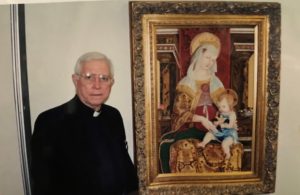
Painting
Fr. Leininger discovered a talent for painting early in life and built upon his passion over his many decades of activity at Jesuit. Comparable to the work of a professional artist, he mainly focused on religiously-themed paintings and always maintained a sense of intricacy and professionalism. The Jesuit Art Museum displays his work throughout the school, the most distinguished of which is the stained-glass cross in Jesuit’s Terry Center. The cross distinguishes itself as the focal point of the room. Mr. Waits ’01 connected Fr. Leininger’s elaborate artwork to his classroom organization: “His works display the same high level of detail and perfection that he demanded from his students in the class.”
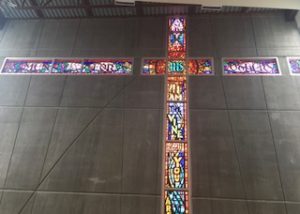
Gambling
In addition to being a proficient painter, Fr. Leininger was also enjoyed gambling, relishing everything from card games to slot machines, as Mr. Waits explained:
“Many alums might not know this, but he had quite the penchant for card games and even the slot machines. Those students that do know this probably lost to him at poker during Ranger Day each fall, when he would play it in the cafeteria and beat all the students. CA could readily spout the differences in the probabilities of winning a hand of blackjack versus five-card draw. In his later years, friends would drive him to Winstar or Choctaw Casino in Oklahoma so he could get his fix of pulling the handle of a Lucky Sevens machine.”
Stamp Collecting
 Father Leininger also actively pursued the hobby of stamp collecting for over 60 years. Over these 6 decades, Fr. Leininger bought, collected, and traded over a million stamps from what he described in a 2010 RoundUp interview as “from practically every country in the world.”
Father Leininger also actively pursued the hobby of stamp collecting for over 60 years. Over these 6 decades, Fr. Leininger bought, collected, and traded over a million stamps from what he described in a 2010 RoundUp interview as “from practically every country in the world.”
He went on to express his preference of Vatican stamps:
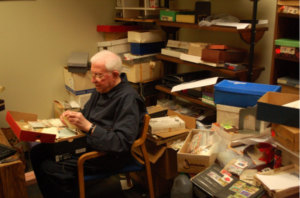
“I had a secretary who gave me a whole group of Vatican stamps that she collected, and it was very disparate, so I decided to unify it, so that was when I began collecting Vatican stamps. That was in 1965. I have a certain set of Vatican stamps. There are only six stamps, but it took me about 11 years to get these stamps because these six stamps cost me $1200. The stamps that the Vatican put out when the Sistine Chapel was restored are a beautiful set.”
To say that Father Leininger left his mark on the Jesuit Dallas community would be an understatement. He is duly credited for facilitating the change that has formed Jesuit into the unique place it is today. He is memorialized by the decades of service through which transformed the lives of his fellow Jesuits, faculty members, and thousands of students. Extending beyond merely the education of his students, his scholarly zeal more significantly transformed the boys he taught into grounded, young men for others.
**Father Leininger’s biographic information was adapted from an obituary published by Jesuit’s advancement office, linked here


